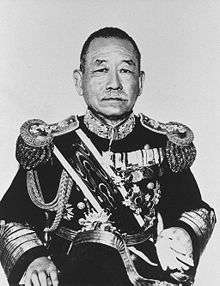Keisuke Okada
Keisuke Okada (岡田 啓介, Okada Keisuke, 20 January 1868 – 7 October 1952) was an admiral in the Imperial Japanese Navy, politician and Prime Minister of Japan from 1934 to 1936.
Okada Keisuke | |
|---|---|
岡田 啓介 | |
 | |
| Prime Minister of Japan | |
| In office 8 July 1934 – 9 March 1936 | |
| Monarch | Shōwa |
| Preceded by | Makoto Saitō |
| Succeeded by | Kōki Hirota |
| Minister of the Imperial Japanese Navy | |
| In office 20 April 1927 – 9 January 1933 | |
| Prime Minister | Tanaka Giichi |
| Preceded by | Takarabe Takeshi |
| Succeeded by | Takarabe Takeshi |
| In office 26 May 1932 – 9 January 1933 | |
| Prime Minister | Saitō Makoto |
| Preceded by | Ōsumi Mineo |
| Succeeded by | Ōsumi Mineo |
| Personal details | |
| Born | 20 January 1868 Fukui, Japan |
| Died | 7 October 1952 (aged 84) |
| Political party | Independent |
| Alma mater | Imperial Japanese Naval Academy |
| Profession | Admiral |
| Signature |  |
Biography
Early life
Okada was born in what is now Fukui Prefecture to an ex-samurai family. He attended the 15th class of the Imperial Japanese Naval Academy, graduating 7th out of a class of 80 cadets in 1889. He served as a midshipman on the ironclad warship Kongō and the cruiser Naniwa. He was commissioned an ensign on 9 July 1890. He later served as lieutenant on the Itsukushima and Takachiho as well as the corvette Hiei.[1]
In the First Sino-Japanese War, Okada served on the Fuji. After his graduation from the Naval Staff College, he subsequently served on the Shikishima and as executive officer on the Yaeyama. He was promoted to lieutenant on 9 December 1894, to lieutenant-commander on 29 September 1899 and to commander on 13 July 1904.
During the Russo-Japanese War, Okada served as executive officer on a successor of vessels, including the Chitose, Kasuga and Asahi. He was promoted to captain on 25 September 1908 and given his own command, the Kasuga on 25 July 1910. He later transferred to the Kashima in 1912.
Promoted to rear admiral on 1 December 1913, Okada served in a number of desk jobs thereafter, including that of the Naval Shipbuilding Command. He was promoted to vice admiral on 1 December 1917 and to full admiral on 11 June 1924.
Okada assumed the post of Commander-in-chief of the Combined Fleet in 1924. In 1927, he became Minister of Navy in the administration of Tanaka Giichi, but resigned in 1929 to assume the post of military councillor on the Supreme War Council.
Okada was one of the few supporters (Treaty Faction) within the upper ranks of the Imperial Japanese Navy of the arms reduction treaty resulting from the London Naval Treaty of 1930, which he helped negotiate and worked hard for its ratification. He again served as Navy Minister in the Saitō Makoto cabinet of 1932.
Okada entered the reserves on 21 January 1933 and retired five years later.

Political career
In July 1934, Okada was named Prime Minister of Japan holding simultaneously the portfolio of Minister of Colonial Affairs. In the month of September 1935, he also briefly held the portfolio of Minister of Post and Telecommunications. Okada was one of the democratic and moderate voices against the increasing strength of the militarists, and was therefore a major target for extremist forces pushing for a more totalitarian Japan. He narrowly escaped assassination in the February 26 Incident of 1936, largely because rebel troops killed Colonel Denzō Matsuo, brother-in-law as well as personal secretary of Okada's, by misidentifying him as the prime minister. Okada emerged from hiding on 29 February 1936. However, he left office a few days later.
Okada was adamant in his opposition to the war with the United States. During World War II, Okada formed a group of like-minded politicians and military officers seeking an early end to the hostilities. After the defeat of Japanese forces at the Battle of Midway and Battle of Guadalcanal, Okada pushed for negotiations with the Allies, and played a leading role in the overthrow of the Hideki Tōjō cabinet in 1944.
Okada died in 1952, and his grave is at the Tama Reien Cemetery, in Fuchū, Tokyo.
Honors
From the corresponding article in the Japanese Wikipedia
- Order of the Golden Kite, (3rd class) (1915)
- Grand Cordon of the Order of the Rising Sun (1920)
- Grand Cordon of the Order of the Paulownia Flowers (1933)
See also
Notes
- Nishida, Imperial Japanese Navy
References
- Bix, Herbert P. (2001). Hirohito and the Making of Modern Japan. Harper Perennial. ISBN 978-0-06-019314-0; OCLC 247018161
- Brendon, Piers (2002). The Dark Valley: A Panorama of the 1930s. Vintage; Reprint edition. ISBN 0-375-70808-1.
- Gordon, Andrew (2003). A Modern History of Japan: From Tokugawa Times to the Present. Oxford University Press. ISBN 0-19-511061-7.
- Jansen, Marius B (2002). The Making of Modern Japan. Harvard University Press. ISBN 9780674003347; OCLC 44090600
External links
- Nishida, Hiroshi. "Materials of IJN: Okada, Keisuke". Imperial Japanese Navy. Archived from the original on 2013-01-04. Retrieved 2007-08-03.
- Newspaper clippings about Keisuke Okada in the 20th Century Press Archives of the ZBW
| Wikimedia Commons has media related to Keisuke Okada. |